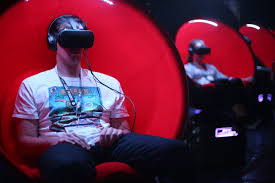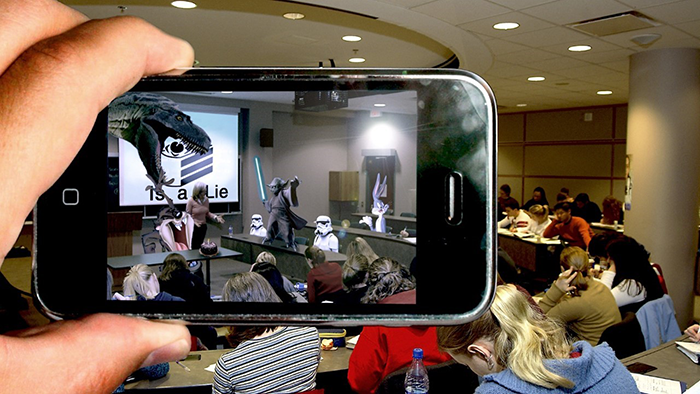Impacts of Augmented Reality and Virtual Reality in various industries
Augmented reality, is a live direct or indirect view of a physical, real-world environment whose elements are augmented by computer-generated sensory input such as sound, video, graphics or GPS data whereas Virtual reality is a computer technology that uses Virtual reality headsets, sometimes in combination with physical spaces or multi-projected environments, to generate realistic images, sounds and other sensations that simulate a user’s physical presence in a virtual or imaginary environment.

Magnify and Business Summit event creator Matt Coleman said the industry was growing at an unprecedented rate. He added “When we held the first summit on this topic a year ago, it seemed that AR/VR was about to become big” .
AR and VR in Sports
“VR will be huge, but it will only be a samll subset of AR” – Jody Medich , Singularity University. AR will enhance the training as well as in game performance. Intel believes the next level of virtual and augmented reality is a combination of the two—merged reality—and sees the sports landscape as the ideal place to bring its new innovations to life. Will you soon be able to buy a virtual ticket the game? Half a century after the first VR headset was built by American computer scientist Ivan Sutherland, virtual reality still isn’t quite reality. But Intel’s CEO Brian Krzanich is banking on his company to fix that, and sports, he believes, might be the perfect playground for VR.
“our goal is that you could take any sport and through VR pick your seat,” says Krzanic. Selling virtual tickets could significantly add to league revenues, especially since major teams already have the untapped potential of fanbases that just won’t physically fit inside their stadiums.
If even a fraction of the several hundred million expected to watch the Super Bowl paid a small percent of the in-person ticket prices for a virtual experience that would represent a whole lot of real money.
AR and VR in Tourism
Augmented reality (AR) technology, however, is revolutionizing the traveler’s experience by making the planning journey much more seamless, interactive, and simple. This technology makes it possible to layer digital enhancements over an existing reality or real life scenario. For tourism, this means that booking your hotel, accessing information while you’re there, navigating around your destination, translating written or spoken signs or conversations, and locating dining and entertainment options can all be done simply through an app on your mobile devices.
Unlike other products which can be displayed or inspected at the point of sale before it is purchased, tourism is too intangible a product to be promoted in such a manner. Hence, videos have always played a crucial role in tourism and travel promotion. Virtual Reality can take these videos to the next level. With Virtual Reality, the participants find themselves in the same dimension as and are immersed in the information. The Virtual Environment is augmented by various sensory simulations such as sight, sound, and even touch, together with their respective feedback.
Virtual tours can offer a realistic tourist experience to those people who are unable to travel due to physical, financial or time constraints. Virtual Reality can help such people to literally travel through time and space from the comfort and safety of their homes. Also, there are certain locations that ecologically fragile (e.g. coral reefs) or are heritage sites (e.g. Ajanta caves). Large numbers of tourists would be detrimental to such locations. Here virtual tourism can play an important role in providing sustainable tourism solutions.
AR and VR in Film and Television
Augmented reality has historically been confined to the realm of computer scientests and marketers, but the inspiring nature and exciting potential of the technology has recently captured the interest of popular culture. New applications of AR are being woven into the narratives and set pieces of film, TV and theatre to enable new ways to tell stories and communicate drama. Many of these applications are fictional, but technology is rapidly catching up with the imaginations of storytellers.
Virtual reality is a very common theme in science fiction movies, where it is often used a way to turn fantastical into something that seems totally real.
TRON, for instance, was one of the first movies to use virtual reality as a plot element. The main characters were taken from reality and transported into a virtual world inside a computer. This is not 100% like the virtual reality we know today but the concept of another reality inside of a computer reminds the same.
AR and VR in Finance
Within a bank, AR has the potential to transform productivity. Data visualisation is a key tool for traders needing to make important data-driven decisions quickly. AR can help traders view, analyse and manipulate large quantities of complex data faster through a more intuitive AR interface. Several companies have trialled Oculus Rift to create immersive 3D virtual reality environments for analysing data. Citibank has taken the next step by using Microsoft’s HoloLens headset to create Holographic Workstations for traders. These headsets use AR to layer complex data sets that enable traders to visualise and make decisions collaboratively with clients. We can expect to see more AR in bank offices in the future.
VR has the potential to be the decisive tool needed to rectify many problems in the financial services industry. This device would immediately allow for the display of dynamic data, which in turn could be simplified into a clearer form.
For example, Virtualitics is an immersive virtual space that allows people to interact with data using the Oculus Rift. This creates the chance for live collaboration and an ‘on the go’ presentation of different asset classes, volatility movements, price points, etc. Investors could communicate in the same virtual space, from numerous geographical areas in the same trading session.




